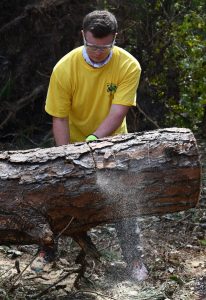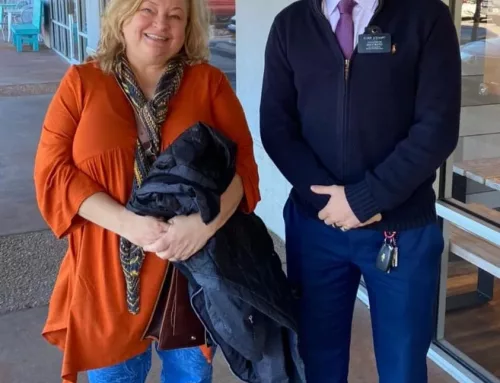Estimated reading time: 5 minutes
At the core of beliefs held by members of The Church of Jesus Christ of Latter-day Saints is a willingness to serve other people.
The Church’s Helping Hands program is the fulfillment of that belief.
Whenever a hurricane or other natural disaster occurs, Helping Hands volunteers don those ubiquitous yellow t-shirts and head off to points in the Southeast to render service to those in need.
“It’s Christian faith put into action,” said Mark Llewellyn, a leader in the Tallahassee Stake of the Church of Jesus Christ—which includes congregations in Tallahassee (7), Thomasville, Cairo, Quincy, Crawfordville, Perry, and Madison.
He pointed out that, to these followers of Jesus Christ, service is a key component to their faith. They enthusiastically donate their time and skills to serve those who have suffered disaster-related losses.
“Helping Hands is a blessing to those who receive help, as well as to those who serve,” said Llewellyn. “It’s wonderful. I’ve never talked to anyone who dealt with Helping Hands who wasn’t positive about their experience.”
Helping Hands projects extend throughout the United States and across the world—into Africa, Asia, Europe, Latin America, and the Pacific. But in northwest Florida and southwest Georgia, hurricane season always brings the threat of disaster.
After Hurricane Andrew hit in 1992, Llewellyn began volunteering with the fledgling Helping Hands program, and he continues today as clean-up efforts continue in the aftermath of Hurricane Sally.
Recalling his post-Andrew efforts, Llewellyn described traveling to a particular disaster site with a group of Church youth and concentrating efforts on one hard-hit family’s home. “How grateful they were for the help,” he said. “That early experience has lasted in my heart for a long time.”
Helping Hands has grown considerably since then. Today, it is a highly organized endeavor that includes planning and pre-positioning of materials well before disaster strikes. Latter-day Saint leaders across the southeastern U.S. conduct extensive advance planning and assignment of responsibilities so that, when the need arises, people are mobilized at every level—regional, statewide, and in local communities.
How it works
If a strong storm were to strike the Panhandle, for example, volunteers might come from Tennessee, well trained to organize, set up, and run operations centers at the disaster site. In this way, local leaders and volunteers can concentrate on recovery without having to oversee the large numbers of volunteers that pour in.
In addition, The Church has warehouses throughout the Southeast that distribute many thousands of dollars in supplies to affected areas.
When Hurricane Michael slammed Florida in 2018, Llewellyn said school boards in the Panhandle area approved opening school grounds for volunteer camps and their gyms so that restrooms and showers were available. “They were a great support.”
The Church also acts in concert with government and non-profit entities. “Governments and non-profits are always preparing for catastrophic events,” said Llewellyn, “and we join them in that preparation. We cooperate with local law enforcement and participate in community organizations like COAD (Community Organizations Active in Disaster), so that Helping Hands can contribute in the most effective ways.”
Part of that effectiveness means prioritizing aid. “Coordinating with law enforcement and COAD, we reach out to first responders immediately,” Llewellyn said. “We help them so they can freely help others. Then we turn our attention to the elderly, widows, the handicapped, the stranded. We keep going back until all our work orders are completed in the affected community.”

ELEVATION – Lane Wright, Richard Garst, and Jason Beyer work on cutting up downed trees in Daphne, Alabama.
Most recently, Helping Hands volunteers traveled from the Tallahassee area to Pensacola, Florida and Daphne, Alabama to join in post-Hurricane Sally relief efforts. One of these workers is Joshua Matson, who described the motivation shared by Latter-day Saints who gladly offer their services weekend after weekend.
“They make a promise with each other and with God that they will help bear one another’s burdens,” he said. “It’s what God would have us do … to simply love our neighbor.”
To request help for yourself or someone in Hurricane Sally disaster areas, go to the free public website crisiscleanup.org.









